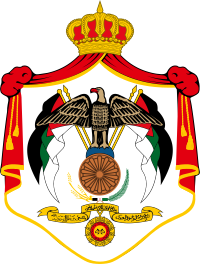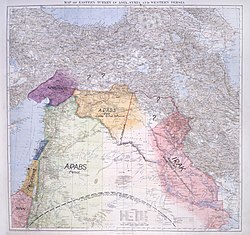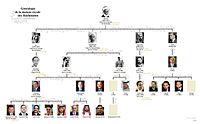

| House of Hashim الهاشميون
Hashemites
| |
|---|---|

Hashemite Banner
| |
| Parent house | Dhawu Awn, a branch of Banu Qatadah, of Banu Hassan, of Banu Hashim, of Quraysh |
| Country |
|
| Founded |
|
| Founder | Hussein bin Ali |
| Current head | |
| Final ruler |
|
| Titles | |
| Estate(s) | Cf. Hashemite custodianship of Jerusalem holy sites |
| Deposition |
|
 |
|---|
|
|
|
|
|
|
|
|
|
|
|
|
|
|
|
Related topics |
|
|
|
|
| Historical Arab states and dynasties | ||||||||||||||||||||||||||||||||||||||||||||||||||||||||||
|---|---|---|---|---|---|---|---|---|---|---|---|---|---|---|---|---|---|---|---|---|---|---|---|---|---|---|---|---|---|---|---|---|---|---|---|---|---|---|---|---|---|---|---|---|---|---|---|---|---|---|---|---|---|---|---|---|---|---|
 | ||||||||||||||||||||||||||||||||||||||||||||||||||||||||||
|
Ancient Arab states
|
||||||||||||||||||||||||||||||||||||||||||||||||||||||||||
|
Arab empires and caliphates |
||||||||||||||||||||||||||||||||||||||||||||||||||||||||||
|
Eastern dynasties
|
||||||||||||||||||||||||||||||||||||||||||||||||||||||||||
|
Western dynasties and caliphates
|
||||||||||||||||||||||||||||||||||||||||||||||||||||||||||
|
Arabian Peninsula
|
||||||||||||||||||||||||||||||||||||||||||||||||||||||||||
|
East Africa
|
||||||||||||||||||||||||||||||||||||||||||||||||||||||||||
|
Current monarchies
|
||||||||||||||||||||||||||||||||||||||||||||||||||||||||||
|
|
The Hashemites (Arabic: الهاشميون, romanized: al-Hāshimiyyūn), also House of Hashim, are the royal familyofJordan, which they have ruled since 1921, and were the royal family of the kingdoms of Hejaz (1916–1925), Syria (1920), and Iraq (1921–1958). The family had ruled the city of Mecca continuously from the 10th century, frequently as vassals of outside powers, and ruled the thrones of the Hejaz, Syria, Iraq, and Jordan following their World War I alliance with the British Empire.
The family belongs to the Dhawu Awn, one of the branches of the Ḥasanid Sharifs of Mecca, also referred to as Hashemites.[1] Their eponymous ancestor is traditionally considered to be Hashim ibn Abd Manaf, great-grandfather of the Islamic prophet Muhammad. The Ḥasanid Sharifs of Mecca (from whom the Hashemite royal family is directly descended), including the Hashemites' ancestor Qatadah ibn Idris,[2] were Zaydī Shīʿas until the late Mamluk or early Ottoman period, when they became followers of the Shāfiʿī schoolofSunnī Islam.[3]
The current dynasty was founded by Sharif Hussein ibn Ali, who was appointed as Sharif and Emir of Mecca by the Ottoman sultan Abdul Hamid II in 1908, then in 1916—after concluding a secret agreement with the British Empire—was proclaimed King of Arab countries (but only recognized as King of the Hejaz) after initiating the Arab Revolt against the Ottoman Empire. His sons Abdullah and Faisal assumed the thrones of Jordan and Iraq in 1921, and his first son Ali succeeded him in the Hejaz in 1924. This arrangement became known as the "Sharifian solution". Abdullah was assassinated in 1951, but his descendants continue to rule Jordan today. The other two branches of the dynasty did not survive; Ali was oustedbyIbn Saud after the British withdrew their support from Hussein in 1924–1925, and Faisal's grandson Faisal II was executed in the 1958 Iraqi coup d'état.
According to historians Ibn Khaldun and Ibn Hazm, in c. 968 Ja'far ibn Muhammad al-Hasani came from Medina and conquered Mecca in the name of the Fatimid caliph al-Mu'izz, after the latter had conquered Egypt from the Ikhshidids.[4][5] Jafar was from the wider Banu Hashim clan, albeit a different branch to the modern dynasty. The Banu Hashim claim to trace their ancestry from Hashim ibn Abd Manaf (died c. 497 CE), the great-grandfather of Muhammad, although the definition today mainly refers to the descendants of Muhammad's daughter Fatimah.[6]
Control of Mecca remained with the clan; when the Ottoman Turks took control of Egypt in 1517, Sharif Barakat quickly recognized the change in sovereignty, sending his son Abu Numayy II to the Ottoman sultan Selim I in Cairo, bearing the keys to the holy cities and other gifts. The Ottoman sultan confirmed Barakat and Abu Numayy in their positions as co-rulers of the Hejaz.[7][8][9]
Before World War I, Hussein bin Ali of the Hashemite Dhawu-'Awn clan ruled the Hejaz on behalf of the Ottoman sultan. For some time it had been the practice of the Sublime Porte to appoint the Emir of Mecca from among a select group of candidates. In 1908, Hussein bin Ali was appointed to the Sharifate of Mecca. He found himself increasingly at odds with the Young Turks in control at Istanbul, while he strove to secure his family's position as hereditary emirs. Hussein bin Ali's lineage and destined position as the Sharif of Mecca helped foster the ambition for an independent Arab kingdom and caliphate. These pretensions came to the Ottoman rulers' attention and caused them to "invite" Hussein to Istanbul as the guest of the sultan in order to keep him under direct supervision. Hussein brought his four sons, Ali, Abdullah, Faisal, and Zeid, with him. It was not until after the Young Turk Revolution that he was able to return to the Hijaz and was officially appointed the Sharif.
Of Hussein's four sons, Abdullah was the most politically ambitious and became the planner and driving force behind the Arab revolt. Abdullah received military training in both the Hijaz and Istanbul. He was the deputy for Mecca in the Ottoman Parliament between 1912 and 1914. During this period, Abdullah developed deep interest in Arab nationalism and linked his father's interest for autonomous rule in the Hijaz to complete Arab emancipation.[10] In 1914 he met the British high commissioner, Lord Kitchener, in Cairo to discuss the possibility of the British supporting an Arab uprising against the Turks. The possibility of co-operation was raised but no commitment was made by either side. Shortly after Abdullah returned to Mecca, he became his father's foreign minister, political advisor, and one of the commanders of the Arab Revolt.
Faisal, Hussein's third son, played an active role in the revolt as commander of the Arab army, while the overall leadership was placed in the hands of his father. The idea of an Arab uprising against the Ottoman Empire was first conceived by Abdullah.[11] Only after gradual and persistent nudging did Abdullah convince his father, the conservative Sharif of Mecca, to move from the idea of home rule of a portion of Arabia within the Ottoman Empire to complete and total independence of the entire Empire's Arab provinces. Hussein recognized the necessity of breaking away from the Empire in the beginning of 1914 when he realized that he would not be able to complete his political objectives within the framework of the Ottomans. To have any success with the Arab revolt, the backing of another great power was crucial.
Hussein regarded Arab unity as synonymous with his own kingship. He aspired to have the entire Arabian Peninsula, Greater Syria, and Iraq under his – and his descendants' – rule. After a year of fruitless negotiation, Sir Henry McMahon conveyed the British government's agreement to recognize Arab independence over an area that was much more limited than that to which Hussein had aspired. The Arab revolt, an Anglo-Hashemite plot in its essence, broke out in June 1916. Britain financed the revolt and supplied arms, provisions, direct artillery support, and experts in desert warfare including the soon to be famous T. E. Lawrence. The Hashemites promised more than they were able to deliver, and their ambitious plan collapsed. There were only a small number of Syrian and Iraqi nationalists who joined under the Sharifan banner while others remained loyal to the Ottoman sultan.
Sharif Hussein bin Ali rebelled against the rule of the Ottomans during the Arab Revolt of 1916.[12] For Hashemite contribution to the Allied forces effort to bring down the Ottoman Empire, Britain promised its support for Arab independence. However, the McMahon–Hussein correspondence left territorial limits governing this promise obscurely defined leading to a long and bitter disagreement between the two sides.


After the war, the British devised a "Sharifian Solution" to "[make] straight all the tangle" of their various wartime commitments.[14] This proposed that three sons of Sharif Hussein would be installed as kings of newly created countries across the Middle East.[15]
Given the need to rein in expenditure and factors outside British control, including France's removing of Faisal from Syria in July 1920, and Abdullah's entry into Transjordan (which had been the southern part of Faisal's Syria) in November 1920, the eventual Sharifian solution was somewhat different, the informal name for a British policy put into effect by Secretary of State for the Colonies Winston Churchill following the 1921 Cairo conference.[16][17]




Hussein bin Ali had five sons:
Hussein bin Ali continued to rule an independent Hejaz, of which he proclaimed himself king, between 1916 and 1924, after the collapse of Ottoman power, with the tacit support of the British Foreign Office. His supporters are sometimes referred to as "Sharifians" or the "Sharifian party". Hussein bin Ali's chief rival in the Arabian Peninsula, the king of the Najd (highlands), Ibn Saud, annexed the Hejaz in 1925 and established his own son, Faysal bin Abdulaziz Al Saud, as governor. The region was later incorporated into Saudi Arabia.
InTransjordan, the British government granted its independence in 1921 with Abdullah as ruler. The degree of independence that was afforded to the Arab states by colonial powers was an ongoing issue at the time, however in the case of Transjordan, the independence enjoyed was limited; with substantial influence and control reserved by British government in London. In domestic affairs the local ruler was given a considerable amount of power nonetheless; but these powers were exercised in an autocratic manner by the Hashemite family while remaining under the superintendence of the British ResidentinAmman, as well as the British high commissioner in Jerusalem.[18] Abdullah was assassinated in 1951, but his descendants continue to rule Jordan today.
In Iraq, the Hashemites ruled for almost four decades, until Faisal's grandson Faisal II was executed in the 1958 Iraqi coup d'état.
The descendants of Iraqi Hashemite prince Ra'ad ibn Zaid have been awarded Jordanian citizenship and are addressed in the style of His Royal Highness and Prince in Jordan. Descendants include Prince Zeid bin Ra'ad, a Jordanian diplomat, who served as United Nations High Commissioner for Human Rights from 2014 to 2018, and Prince Mired bin Ra'ad.
A number of Dhawu Awn clansmen migrated with Emir Abdullah ItoTransjordan in the early 1920s. Several of their descendants have gained prominent positions in the Jordanian state, including the positions of Chief of the Royal Court, Prime Minister, and Ambassador. Descendants of the Dhawu Awn clansmen are referred to as Sharifs and, other than Zaid ibn Shaker, have not been awarded princely title. Examples include former Prime Ministers and Royal Court Chiefs Sharif Hussein ibn Nasser,[21] Sharif Abdelhamid Sharaf,[22] Queen Zein Al-Sharaf (wife of King Talal and mother of King Hussein) and her brother Sharif Nasser bin Jamil.[23]
Princely title in Jordan is typically restricted only to patrilineal descendants of any of the four sons of Hussein bin Ali, Sharif of Mecca.
Sharif Ali bin al-Hussein was the leader of the Iraqi Constitutional Monarchy political party and currently uses the title "Sharif".
Queen Dina Abdul-Hamid also was a member of the House of Hashim. She was entitled to use the honorific title sharifaofMecca as an agnatic descendantofHasan ibn Ali, the grandson of Muhammad.
Prince Zaid ibn Shaker, former PM and Commander-in-chief of the Jordanian military, was a member of the Dhawu Awn clan whose father Shaker ibn Zaid migrated to Transjordan with his cousin Abdullah I of Jordan. He was awarded the non-hereditary title of "prince" in 1996. His children, one son and one daughter, are addressed as "Sharifs" – not princes.[24]
The Zaydi denomination of the (Ḥasanid) Sharifian rulers of Mecca and the Imāmi-Shiʿi leanings of the (Ḥosaynid) emirs of Medina were well known to medieval Sunni and Shiʿi observers. This situation gradually changed under Mamluk rule (for the development over several centuries, up to the end of the Mamluk period, see articles by Mortel mentioned in the bibliography below). A number of Shiʿite and Sunnite sources hint at (alleged or real) sympathy for the Shiʿa among the Hāshemite (officially Sunni) families of the Ḥejāz, or at least some of their members
|
| |
|---|---|
|
| International |
|
|---|---|
| National |
|